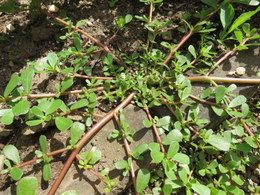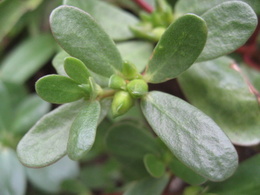Purslane Growing Guide
Purslane (Portulaca oleracea) is likely to be found growing in your garden and flower beds. It is usually thought of as a weed, but it is a nutritious leafy vegetable that can be eaten raw or cooked. Do not pull it out and toss it away, eat it instead and consider it a gift from heaven.
The leaves, stems and flower buds have historically been used around the world as a vegetable. It is high in several vitamins and minerals with a slight lemony, peppery taste and can be used as a substitute or along with lettuce or spinach, as well as an addition to soups and stews.
Purslane is an annual succulent plant with a high-water content with reddish stems and somewhat thick stiff leaves. It is found all over North America, Europe and parts of Asia.
Its growth habit tends to be low and flat to the ground emerging from the central crown in all directions like the spokes of a wheel. It has small inconspicuous yellow or white flowers, that later form small seed pods, which when mature, contain hundreds of very small black seeds. The seeds can be collected from mature seed pods.
Starting From Seed
Follow the seed packet instructions, seeds can be started indoors 6 to 8-weeks before your last expected frost date.
In general sow the seeds 1/4-inch deep in a sterile seed starting mix in cell packs or pots. Lightly cover with the seed starting mix and keep moist. Germination takes 7 to 14-days.
Bottom watering is the easiest way to keep moist without disturbing the newly sown seeds.
You can direct sow in your vegetable garden in the late spring to early summer.
For more detailed information visit the seed starting page.
It can be propagated by taking cuttings and putting in damp soil, which will then root.
Soil Preparation
The soil should be a nice loose well drained organic garden soil, but it will tolerate heavier clay soil conditions.
Planting Purslane
Sow in well-drained soil and thin to 4 to 6-inches apart. You can let them crowd each other a bit, which will keep other competing weeds out.
Watering and Care
It is helpful to place a nice loose mulch of shredded leaves or pine straw to shade the plant roots. This will keep the weeds out, the soil cooler and help retain moisture. Keep the mulch a couple of inches away from the stem. During dry spells give some water each week.
Fertilizing
Fertilizer is usually not needed, but when the flowers appear you can feed with an organic balanced vegetable garden fertilizer such as Espoma Garden-tone.
Harvesting Purslane
If the plant is growing in a place where you do not want it you can pull the entire plant. Otherwise, you can cut the stems back to within 2-inches of the crown. The plant will send out new stems which can be harvested later.
Diseases and Pests
It has very few diseases or pests.
Popular Varieties
Popular Varieties: Goldberg Golden Purslane, Green Purslane.
Sources: Seeds Now, Eden Brothers, Rare Seeds.
Tips and Warnings
The small seed pods burst open when ripe and the plant can be a bit invasive. It can be easily controlled by pulling up the entire plant and discarding it, or better yet, eating it.
Do not confuse purslane with Hairy-Stemmed Spurge (Euphorbia vermiculata) which looks similar, but is poisonous. It has a hairy stem and milky sap, which come out when you squeeze the stem.
Garden Spikes newsletters give you timely information once or twice a month. Subscribe Free to the Garden Times newsletter below.
Your email address will only be used to send you a newsletter and will never be sold. You can unsubscribe at any time.


